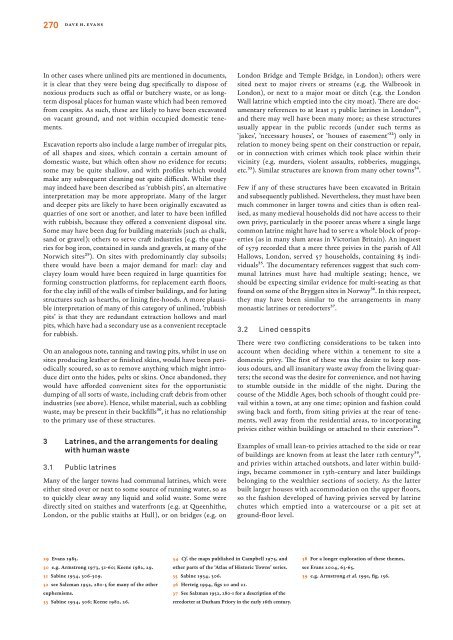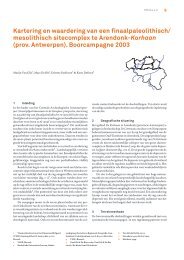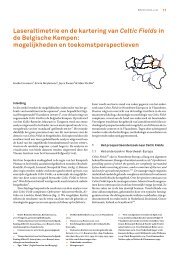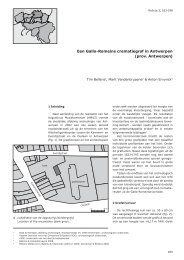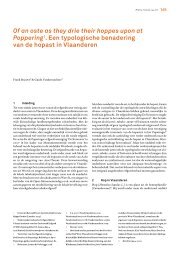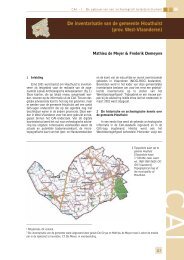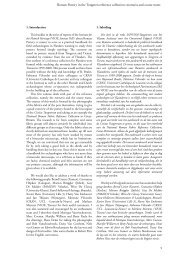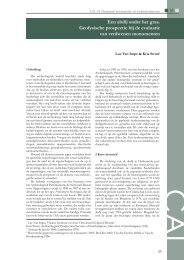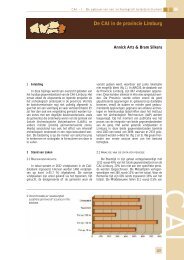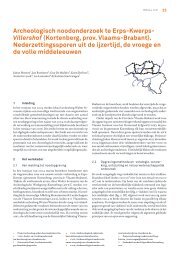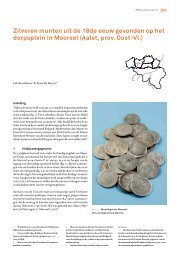Exchanging Medieval Material Culture Studies on archaeology and ...
Exchanging Medieval Material Culture Studies on archaeology and ...
Exchanging Medieval Material Culture Studies on archaeology and ...
You also want an ePaper? Increase the reach of your titles
YUMPU automatically turns print PDFs into web optimized ePapers that Google loves.
270<br />
29 Evans 1985.<br />
Dave H. Evans<br />
In other cases where unlined pits are menti<strong>on</strong>ed in documents,<br />
it is clear that they were being dug specifi cally to dispose of<br />
noxious products such as off al or butchery waste, or as l<strong>on</strong>gterm<br />
disposal places for human waste which had been removed<br />
from cesspits. As such, these are likely to have been excavated<br />
<strong>on</strong> vacant ground, <strong>and</strong> not within occupied domestic tenements.<br />
Excavati<strong>on</strong> reports also include a large number of irregular pits,<br />
of all shapes <strong>and</strong> sizes, which c<strong>on</strong>tain a certain amount of<br />
domestic waste, but which oft en show no evidence for recuts;<br />
some may be quite shallow, <strong>and</strong> with profi les which would<br />
make any subsequent cleaning out quite diffi cult. Whilst they<br />
may indeed have been described as ‘rubbish pits’, an alternative<br />
interpretati<strong>on</strong> may be more appropriate. Many of the larger<br />
<strong>and</strong> deeper pits are likely to have been originally excavated as<br />
quarries of <strong>on</strong>e sort or another, <strong>and</strong> later to have been infi lled<br />
with rubbish, because they off ered a c<strong>on</strong>venient disposal site.<br />
Some may have been dug for building materials (such as chalk,<br />
s<strong>and</strong> or gravel); others to serve craft industries (e.g. the quarries<br />
for bog ir<strong>on</strong>, c<strong>on</strong>tained in s<strong>and</strong>s <strong>and</strong> gravels, at many of the<br />
Norwich sites29). On sites with predominantly clay subsoils;<br />
there would have been a major dem<strong>and</strong> for marl: clay <strong>and</strong><br />
clayey loam would have been required in large quantities for<br />
forming c<strong>on</strong>structi<strong>on</strong> platforms, for replacement earth fl oors,<br />
for the clay infi ll of the walls of timber buildings, <strong>and</strong> for luting<br />
structures such as hearths, or lining fi re-hoods. A more plausible<br />
interpretati<strong>on</strong> of many of this category of unlined, ‘rubbish<br />
pits’ is that they are redundant extracti<strong>on</strong> hollows <strong>and</strong> marl<br />
pits, which have had a sec<strong>on</strong>dary use as a c<strong>on</strong>venient receptacle<br />
for rubbish.<br />
On an analogous note, tanning <strong>and</strong> tawing pits, whilst in use <strong>on</strong><br />
sites producing leather or fi nished skins, would have been periodically<br />
scoured, so as to remove anything which might introduce<br />
dirt <strong>on</strong>to the hides, pelts or skins. Once ab<strong>and</strong><strong>on</strong>ed, they<br />
would have aff orded c<strong>on</strong>venient sites for the opportunistic<br />
dumping of all sorts of waste, including craft debris from other<br />
industries (see above). Hence, whilst material, such as cobbling<br />
waste, may be present in their backfi lls30, it has no relati<strong>on</strong>ship<br />
to the primary use of these structures.<br />
3 Latrines, <strong>and</strong> the arrangements for dealing<br />
with human waste<br />
3.1 Public latrines<br />
Many of the larger towns had communal latrines, which were<br />
either sited over or next to some source of running water, so as<br />
to quickly clear away any liquid <strong>and</strong> solid waste. Some were<br />
directly sited <strong>on</strong> staithes <strong>and</strong> waterfr<strong>on</strong>ts (e.g. at Queenhithe,<br />
L<strong>on</strong>d<strong>on</strong>, or the public staiths at Hull), or <strong>on</strong> bridges (e.g. <strong>on</strong><br />
30 e.g. Armstr<strong>on</strong>g 1973, 51-60; Keene 1982, 29.<br />
31 Sabine 1934, 306-309.<br />
32 see Salzman 1952, 280-5 for many of the other<br />
euphemisms.<br />
33 Sabine 1934, 306; Keene 1982, 26.<br />
34 Cf. the maps published in Campbell 1975, <strong>and</strong><br />
other parts of the ‘Atlas of Historic Towns’ series.<br />
35 Sabine 1934, 306.<br />
36 Herteig 1994, fi gs 20 <strong>and</strong> 21.<br />
37 See Salzman 1952, 280-1 for a descripti<strong>on</strong> of the<br />
reredorter at Durham Priory in the early 16th century.<br />
L<strong>on</strong>d<strong>on</strong> Bridge <strong>and</strong> Temple Bridge, in L<strong>on</strong>d<strong>on</strong>); others were<br />
sited next to major rivers or streams (e.g. the Walbrook in<br />
L<strong>on</strong>d<strong>on</strong>), or next to a major moat or ditch (e.g. the L<strong>on</strong>d<strong>on</strong><br />
Wall latrine which emptied into the city moat). Th ere are documentary<br />
references to at least 13 public latrines in L<strong>on</strong>d<strong>on</strong>31,<br />
<strong>and</strong> there may well have been many more; as these structures<br />
usually appear in the public records (under such terms as<br />
‘jakes’, ‘necessary houses’, or ‘houses of easement’32) <strong>on</strong>ly in<br />
relati<strong>on</strong> to m<strong>on</strong>ey being spent <strong>on</strong> their c<strong>on</strong>structi<strong>on</strong> or repair,<br />
or in c<strong>on</strong>necti<strong>on</strong> with crimes which took place within their<br />
vicinity (e.g. murders, violent assaults, robberies, muggings,<br />
etc.33). Similar structures are known from many other towns34.<br />
Few if any of these structures have been excavated in Britain<br />
<strong>and</strong> subsequently published. Nevertheless, they must have been<br />
much comm<strong>on</strong>er in larger towns <strong>and</strong> cities than is oft en realised,<br />
as many medieval households did not have access to their<br />
own privy, particularly in the poorer areas where a single large<br />
comm<strong>on</strong> latrine might have had to serve a whole block of properties<br />
(as in many slum areas in Victorian Britain). An inquest<br />
of 1579 recorded that a mere three privies in the parish of All<br />
Hallows, L<strong>on</strong>d<strong>on</strong>, served 57 households, c<strong>on</strong>taining 85 individuals35.<br />
Th e documentary references suggest that such communal<br />
latrines must have had multiple seating; hence, we<br />
should be expecting similar evidence for multi-seating as that<br />
found <strong>on</strong> some of the Bryggen sites in Norway36. In this respect,<br />
they may have been similar to the arrangements in many<br />
m<strong>on</strong>astic latrines or reredorters37.<br />
3.2 Lined cesspits<br />
Th ere were two c<strong>on</strong>fl icting c<strong>on</strong>siderati<strong>on</strong>s to be taken into<br />
account when deciding where within a tenement to site a<br />
domestic privy. Th e fi rst of these was the desire to keep noxious<br />
odours, <strong>and</strong> all insanitary waste away from the living quarters;<br />
the sec<strong>on</strong>d was the desire for c<strong>on</strong>venience, <strong>and</strong> not having<br />
to stumble outside in the middle of the night. During the<br />
course of the Middle Ages, both schools of thought could prevail<br />
within a town, at any <strong>on</strong>e time; opini<strong>on</strong> <strong>and</strong> fashi<strong>on</strong> could<br />
swing back <strong>and</strong> forth, from siting privies at the rear of tenements,<br />
well away from the residential areas, to incorporating<br />
privies either within buildings or attached to their exteriors38.<br />
Examples of small lean-to privies attached to the side or rear<br />
of buildings are known from at least the later 12th century39,<br />
<strong>and</strong> privies within attached outshots, <strong>and</strong> later within buildings,<br />
became comm<strong>on</strong>er in 13th-century <strong>and</strong> later buildings<br />
bel<strong>on</strong>ging to the wealthier secti<strong>on</strong>s of society. As the latter<br />
built larger houses with accommodati<strong>on</strong> <strong>on</strong> the upper fl oors,<br />
so the fashi<strong>on</strong> developed of having privies served by latrine<br />
chutes which emptied into a watercourse or a pit set at<br />
ground-fl oor level.<br />
38 For a l<strong>on</strong>ger explorati<strong>on</strong> of these themes,<br />
see Evans 2004, 63-65.<br />
39 e.g. Armstr<strong>on</strong>g et al. 1991, fi g. 156.


